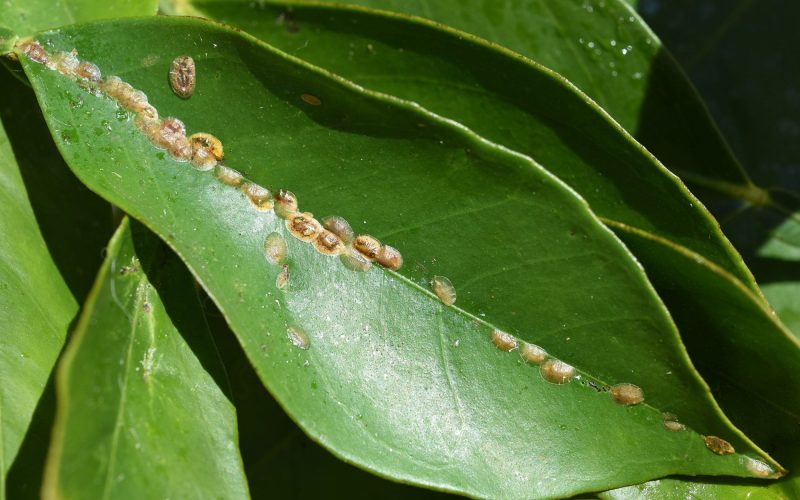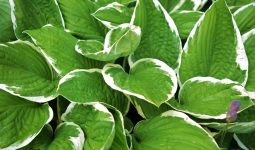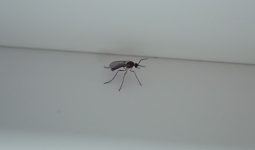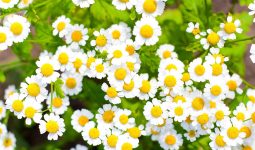There are many types of houseplant bugs, from spider mites to aphids.
These tiny pests are unpleasant to look at and can cause real problems for your houseplants if left unchecked.
Thankfully, there are also numerous ways to keep them out of your houseplants and prevent them from causing damage in the future.
In this guide, we’ll discuss the most common types of houseplant bugs, their identifying characteristics, and how to remove them permanently!
Different Types of Houseplant Bugs
1. Scale
Scale insects are a type of houseplant bug. They are tiny, hard-bodied pests that can attach themselves to the stems, leaves, and sometimes the fruit of houseplants.
They insert their long, piercing mouthparts into the plant tissue and suck the sap. This feeding damages the plant and can cause yellowing leaves, stunted growth, and early leaf drops.
Also, Scale insects can produce a sticky substance called honeydew that attracts ants and promotes the growth of sooty mold on the plant.
2. Whiteflies
Whiteflies are small, winged insects commonly found on the undersides of leaves. They feed on plant sap, which can cause leaves to become yellow and eventually drop off.
Also, Whiteflies can spread diseases from one plant to another. To get rid of whiteflies, start removing plagued plants from your home.
Then, treat the remaining plants with an insecticide explicitly designed for whiteflies. You can also try using a yellow sticky trap to catch them.
3. Aphids
Aphids are tiny, soft-bodied insects that can be found in various colors, including green, black, brown, and yellow. They’re often found on the undersides of leaves, where they suck plant juices.
Aphids are houseplant bugs that can reproduce quickly, so getting rid of them as soon as you see them is essential.
The good news is that there are several different ways to do this. You can use a water hose to blast them off of your plants, or you can try using insecticidal soap. If you have a severe infestation, you may need to resort to chemical pesticides.
4. Spider Mites
These tiny pests are difficult to see with the naked eye, but you may notice their webbing on the undersides of leaves. If you see webbing, that indicates that your plant has spider mites.
Furthermore, these houseplant bugs feed by sucking plant juices, which can cause yellowing or stippling on leaves. Try spraying your plant with water or using a miticide to eliminate spider mites.
5. Mealybugs
Mealybugs are small, white, wingless insects that love to feast on houseplants. They often congregate around plant stems and leaves in warm, humid climates.
Mealybugs can damage your plants, so getting rid of them as soon as you see them is essential. The good news is that you can do a few things to eliminate mealybugs for good.
6. Thrips
Thrips are tiny, winged insects attracted to light-colored flowers. They feast on plant sap, which can cause leaves to become discolored and distorted.
To remove thrips, spray your plants with water to remove any adults or eggs. Then, apply an insecticide designed specifically for thrips. You can also try using yellow sticky traps to catch them.
7. Fungus Gnats
Fungus gnats are small, dark-colored flies that often hover around potted plants. They’re attracted to moist soil, so you probably overwater your plants if you have them.
These houseplant bugs are more of a nuisance than anything else, but they can damage young plants by eating their roots.
Let the top inch or two of the soil dry out before watering again to remove fungus gnats. You can also put a layer of sand on top of the soil to help with drainage. You may need to use an insecticide if you have a severe infestation.
How to Prevent Houseplant Bug Infestation?
Keeping your plants healthy is the best way to prevent these houseplant bugs. Look for early signs of trouble, such as wilting or discoloration, and act quickly.
Also, Inspect new plants before bringing them home, and quarantine any that show signs of pests. Clean up any fallen leaves or flowers, as these can harbor pests.
Finally, check your clothing and hair before handling your plants, as you could be unwittingly transporting pests from one plant to another.
Always store your garden tools in a dry place after use. If you find yourself with a bug infestation on the premises, don’t worry! Follow these steps to eliminate the invaders and maintain peace in the garden.








